What Is Rhombus?
A rhombus is a quadrilateral with four equal sides. Its opposite sides are parallel, and opposite angles are equal.
We know that opposite sides of a parallelogram are equal, a rhombus is a special type of parallelogram with all sides equal. All rhombuses are parallelograms, but not all parallelograms are rhombuses.
Recommended Games
How Is a Rhombus Different from a Square?
The difference between a square and a rhombus is that all angles of a square are right angles, but the angles of a rhombus need not be right angles.
So, a rhombus with four right angles becomes a square.
We can say, “Every square is a rhombus, but all rhombus are not squares.”
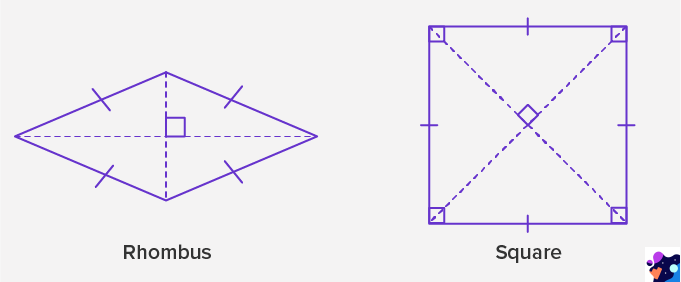
Real-life Examples of a Rhombus Shape
You can find rhombus shapes in various everyday objects around us, such as kites, finger rings, rhombus-shaped earrings, the structure of a window glass pane, etc.

Properties of a Rhombus
Some of the important properties of a rhombus are stated below.
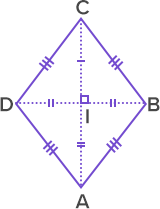
- All sides of a rhombus are equal. Here, AB = BC = CD = DA.
- Diagonals bisect each other at 90°. Here, diagonals AC and BD bisect each other at 90°.
- Opposite sides are parallel in a rhombus. Here, AB ∥ CD and AD ∥ BC.
- Opposite angles are equal in a rhombus. ∠A = ∠C and ∠B = ∠D.
- Adjacent angles add up to 180°.
∠A + ∠B = 180°
∠B + ∠C = 180°
∠C + ∠D = 180°
∠A + ∠D = 180°
- All the interior angles of a rhombus add up to 360°.
- Adjacent angles of a rhombus add up to 180°.
- The diagonals of a rhombus are perpendicular to each other. Here, AC ⟂ BD.
- The diagonals of a rhombus bisect each other. Here, DI = BI and AI = CI.
- A rhombus has a rotational symmetry of 180 degrees (order 2). A rhombus retains its original orientation when rotated by an angle of 180 degrees.
- The diagonals of a rhombus coincide with the 2 lines of symmetry. They divide the rhombus into 2 identical halves.
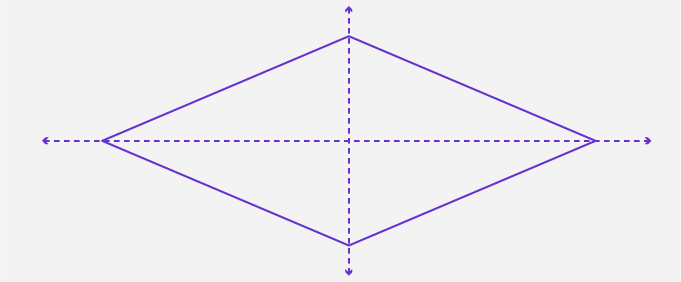
Rhombus Formulas
Let’s discuss important formulas associated with a rhombus.
Area of a Rhombus
The area of a rhombus is the region enclosed by the 4 sides of a rhombus.
There are two ways to find the area of a rhombus.
- Area of a rhombus when its base and altitude are known
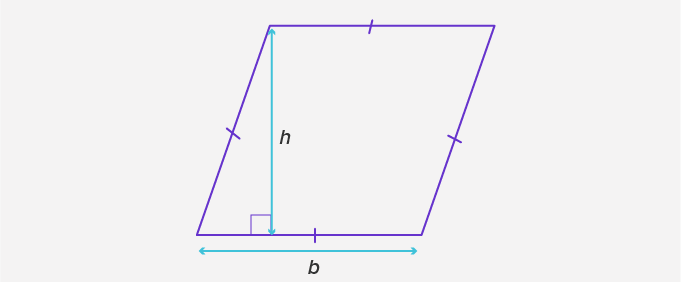
The area of a rhombus is calculated by finding the product of its base and corresponding altitude (height).
Note that you can choose any of its sides as the base, and the perpendicular distance from this side to the opposite side becomes the height.
Area of rhombus = base × height = (b × h) square units.
- Area of a rhombus when the lengths of its diagonals are known
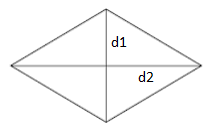
When the lengths of the diagonals of a rhombus are known, then its area is given by half of their product.
Area of rhombus $= \frac{d_{1} \times d_{2}}{2}$ square units
where
d1 and d2 are the lengths of diagonals of a rhombus.
Perimeter of Rhombus
The perimeter of a rhombus is the total length of its boundaries. As all four sides of a rhombus are equal, its perimeter is calculated by multiplying the length of its side by 4.
Perimeter of a rhombus = 4 × a units
where ‘a’ is the length of the side of the rhombus.
Solved Examples on Rhombus
Example 1: The lengths of the two diagonals of a rhombus are 18 cm and 12 cm. Find the area of the rhombus.
Solution:
Diagonal (d1 ) = 18 cm
Diagonal (d2 ) = 12 cm
Area of rhombus $= \frac{d_{1}\times d_{2}}{2} = \frac{18 \times 12}{2}$ sq. cm $= 108$ sq. cm
Example 2: Find the perimeter of the rhombus if one of its sides measures 15 cm.
Solution:
Length of a side of the rhombus (a) = 15 cm
Perimeter of rhombus = 4 × a = 4 × 15 cm = 60 cm
Example 3: The area of a rhombus is 56 sq. cm. If the length of one of its diagonals is 14 cm, find the length of the other diagonal.
Solution:
Area of rhombus = 56 sq. cm
d1 = 14 cm
Area of rhombus $= \frac{d_{1} \times d_{2}}{2}$
⇒ 56 = $\frac{14 \times d2}{2}$
⇒ 56 = 7 × d2
⇒ d2 = 56 ÷ 7
⇒ d2 = 8 cm
So, the second diagonal of the given rhombus measures 8 cm.
Example 4: In a rhombus ABCD, if ∠A = 60°, find the measure of remaining angles.
Solution:
∠A + ∠B = 180° (Adjacent angles adds up to 180°)
60° + ∠B = 180° (Given, ∠A = 60°)
∠B = 180° – 60°
∠B = 120°
∠C = ∠A = 60° (Opposite angles are equal in a rhombus)
∠D = ∠B = 120° (Opposite angles are equal in a rhombus)
Practice Problems on Rhombus
Rhombus
Which of the following quadrilaterals is definitely a rhombus?
All sides of a square are equal, so all squares are rhombus.
If the length of one of the sides of the rhombus is 10 cm. What will be the length of the opposite side of the given rhombus?
All sides of the rhombus are equal in length.
What will be the altitude of the rhombus, whose area is 320 sq. cm and side is 40 cm?
Area = base × altitude
⇒ 320 = 40 × altitude
⇒ altitude = 320 ÷ 40 = 8 cm
The floor area of a room is 500,000 sq. cm. If the floor is to be covered with rhombus-shaped tiles, with each tile having diagonals 40 cm and 25 cm, find the number of tiles required.
Area of floor = 500,000 sq. cm
Area of each rhombus-shaped tile = $\frac{d_{1} \times d_{2}}{2}$ = $\frac{40 \times 25}{2}$ = 500 sq. cm
Number of tiles = Area of floor ÷ Area of 1 tile
= 500,000 ÷ 500
= 1,000 tiles
So, 1,000 tiles are required to cover the floor.
FAQs about Rhombus
What are the basic properties of a rhombus?
- All sides are equal in length.
- Opposite angles are equal in a rhombus.
- The diagonals bisect each other at 90 degrees.
- Adjacent angles add up to 180 degrees.
Is a rhombus a regular polygon?
No, a rhombus is not a regular polygon. A regular polygon must have the measure of all its angles the same (equal).
The diagonals of a rhombus divide the shape into which shapes?
The two diagonals of a rhombus form four right-angled triangles.
Is a kite shaped like a rhombus?
No, a kite shape is not a rhombus. Rhombus has all its sides of equal length whereas kite 2 pairs of equal adjacent sides.

















